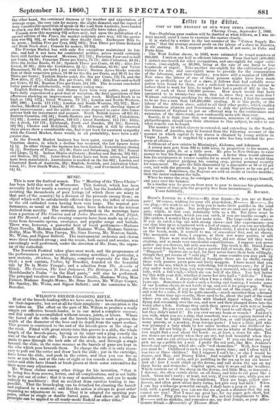Ittirr to Or Cain.
COST OF THE NEGLECT OF 017E WEST INDIA. COLONIES.
Charing Cross' &jambes. 7, 1860. Sin—Doubtless your readers will be startled at what follows, as I was in- deed myself, until I came to examine the matter closely. It is stated by a writer hi the last number of the .4 Cotton Supply Re-
porter," that the average annual profit on the labour of a slave in America, is 451. sterling. It is, I suppose quite as much, if not more, in Cuba and Porto Rice.
• The West Indian slaves, in 1833, were estimated in round numbers at 800,000. I reckon one half as efficient labourers. From that half (400,000) I deduct one-fourth for other occupations, and one-eighth for sugar culti- vation, (one-eighth, or 50,000, being at the rate of one hand to four hogsheads of sugar). Take another one-eighth for the cultivation of pro- visions for sale, and one-eighth more to provide for the consumption of the labourers, and their families ; you have still a surplus of 150,000. Now since the labour of one of these persons might have been made quite as profitable as that of a slave, it follows that had suitable occu- pation been found for them, and a sufficient remuneration for labour to induce them to work for him, he might have had a profit of 45/. in the la- bour of each of these 150,000 persons. How much would that have amounted to in twenty-two years, that is, since they were made free ? Without calculating anything forthe interest of money, I find the amount to be no less a sum than 148,500,000/. sterling. It is this profit, or the labour of the African slave' added to all their other profits, which enables
the American planters and Government to defy the philanthropists and Government of England to put an effectual stop to the continuance and extension of the slave-trade, now confessedly more rife than ever. Surely, it is high time that our statesmen, ministers of religion, and philanthropists should turn their attention to this subject, in order to see what remedy can be found.
The manner in which slavery is extended, and extending in the South- ern States of America, may be learned from the following account of the manner in which capital to buy slaves is obtained by young settlers in Virgin Lands. It is supplied by a person who has long watched the pro- gress of affairs—
Settlement of new estates in Mississippi, Alabama, and Arkansas. I young man gets from 200 to 1000 acres, in proportion to his means, at Government price, 55. or a little over. He goes to New Orleans to raise money to buy his Negroes and implements. A factor then would advance him his acceptances at twelve months for as much money as he would thus require—the planter pledging his coming crop, giving personal security for repayment. He gets the bills discounted by a discounter at 10 or 12 per cent, and with the proceeds he pays for as many Negroes as he can get or may require. Sometimes, the Negroes are sold on credit at twelve months ; then the factor endorses the bills.
When he raises the crop, he consigns it to the factor, who repays himself, and pays over the balance. In a similar way be goes on from year to year to increase his plantation, and in course of time gets the property free from incumbrance.


























 Previous page
Previous page